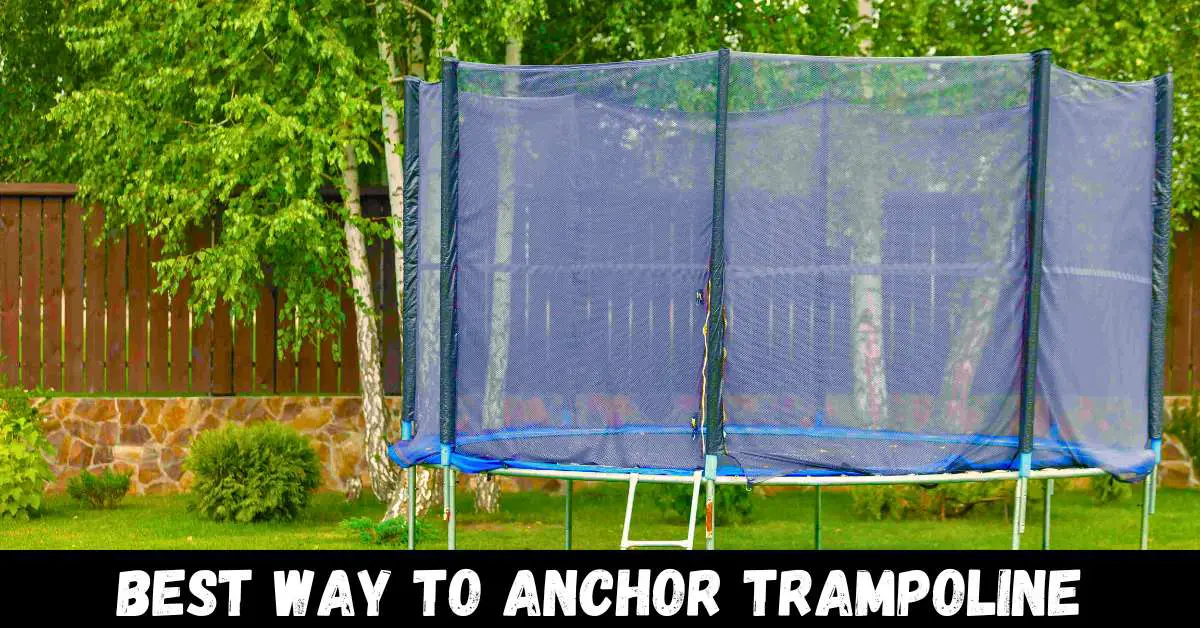Now we will discuss the best way to anchor trampoline. Securing my trampoline against strong winds and big bounces was a breeze, thanks to a trampoline anchor kit. It only took me a matter of minutes to complete this simple project and ensure the safety of my trampoline.
With the U-shaped wind stakes included in the kit, I tapped them into place over the legs of the trampoline, providing an instant solution. Alternatively, I could use auger-style anchors by sinking them into the ground below the frame.
To ensure my trampoline stayed firmly in place, I hooked the provided straps through the augers and tightened them down on each side. I know that my trampoline will remain secure, even during the harshest weather conditions.
This quick and easy solution was effective and gave me the confidence to enjoy my trampoline with utmost safety.
Best Way to Anchor Trampoline: Ensure your trampoline’s stability and safety by using a trampoline anchor kit. Quickly secure it with U-shaped wind stakes or auger-style anchors to withstand strong winds and vigorous bouncing.
At what times or situations do you require the anchoring of a trampoline?
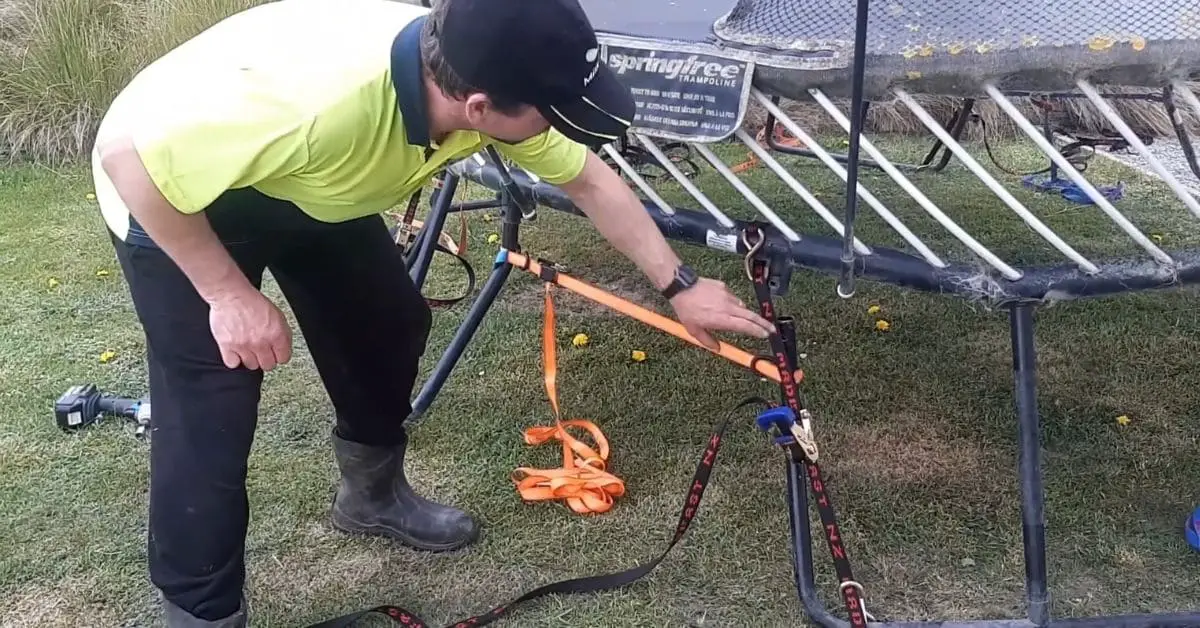
It is important to always anchor an outdoor trampoline before using it, regardless of whether there will be strong winds. Even your jumping movements on the trampoline can cause it to move, leading to safety issues and impacting your enjoyment.
However, extra precautions should be taken when there are strong winds to prevent the trampoline from blowing away.
It’s important to always anchor your outdoor trampoline, even when the wind is not strong. When there are heavy winds, you need to take extra precautions to prevent the trampoline from being blown away.
If there’s severe weather like a hurricane, bringing your trampoline inside your house is best. In the United States, hurricanes are most common in states like Florida, Texas, Louisiana, North and South Carolina, Georgia, New York, Mississippi, Virginia, and others.
The months from June to October are known to have the highest risk of experiencing such severe weather conditions.
What tools are needed to anchor a trampoline securely?
To anchor a trampoline securely, you will need the following tools:
Anchoring Trampolines with Heavy Duty Anchors
Regarding trampoline anchors, you can find different types categorized as light-duty, middle-duty, and heavy-duty. The choice of anchor depends on the weather conditions in your area.
A light-duty anchor should be sufficient to secure your trampoline if you live in a region that rarely experiences severe weather events such as storms or hurricanes. These anchors are designed to withstand moderate winds and normal bouncing activities.
However, investing in heavy-duty trampoline anchors is advisable if you reside in an area prone to harsh weather conditions or frequently face strong winds. These anchors are specifically designed to provide extra stability and safety during extreme weather conditions.
They are built to withstand powerful gusts of wind and vigorous bouncing on the trampoline.
By opting for heavy-duty trampoline anchors in areas with frequent storms or hurricanes, you can ensure that your trampoline remains securely in place, minimizing the risk of damage or accidents. Prioritizing stability and safety is crucial to protect the trampoline and the individuals using it.
Securing Trampolines with Stakes:
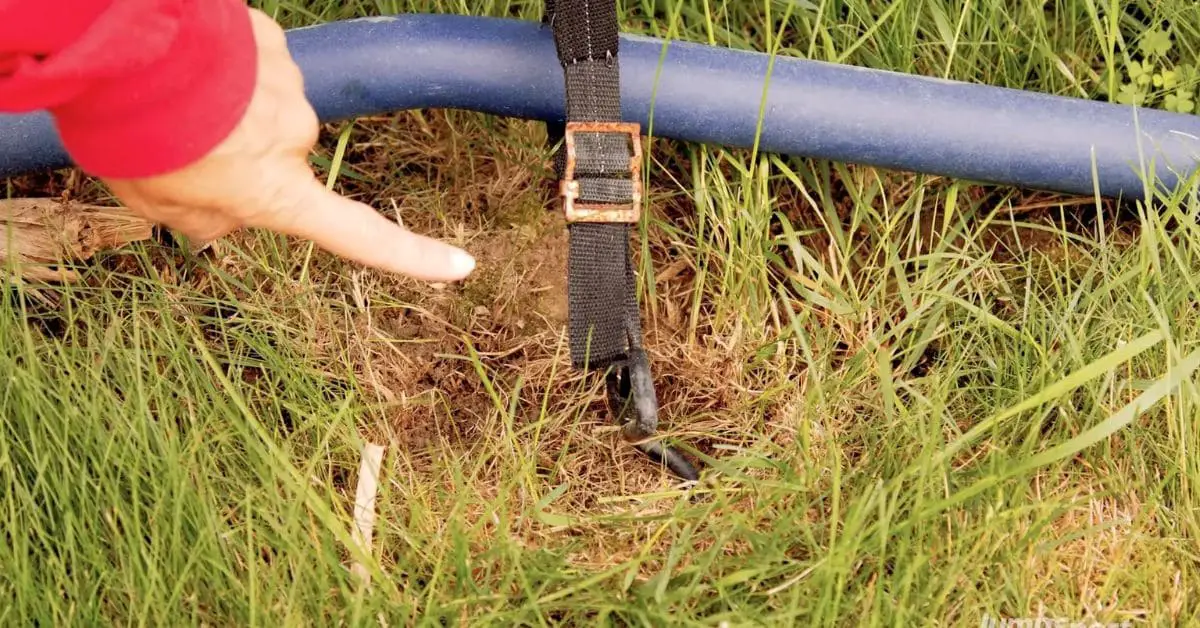
Most trampoline brands provide trampoline anchor kits along with the trampoline purchase. These kits typically include U-shaped stakes or auger-style anchors.
The U-shaped stakes can be placed over the frame legs of the trampoline to secure it, while the auger-style anchors are inserted into the ground below the legs using brackets.
Some people may consider using sandbags or other solid items as alternatives to trampoline anchor kits. However, it’s important to note that these alternatives may not provide the same level of safety.
There is a risk of injury if someone accidentally falls onto these hard objects. Therefore, it’s generally recommended to use the trampoline anchor kits that come with the trampoline for optimal safety and stability.
Securing Trampolines with Sandbags:
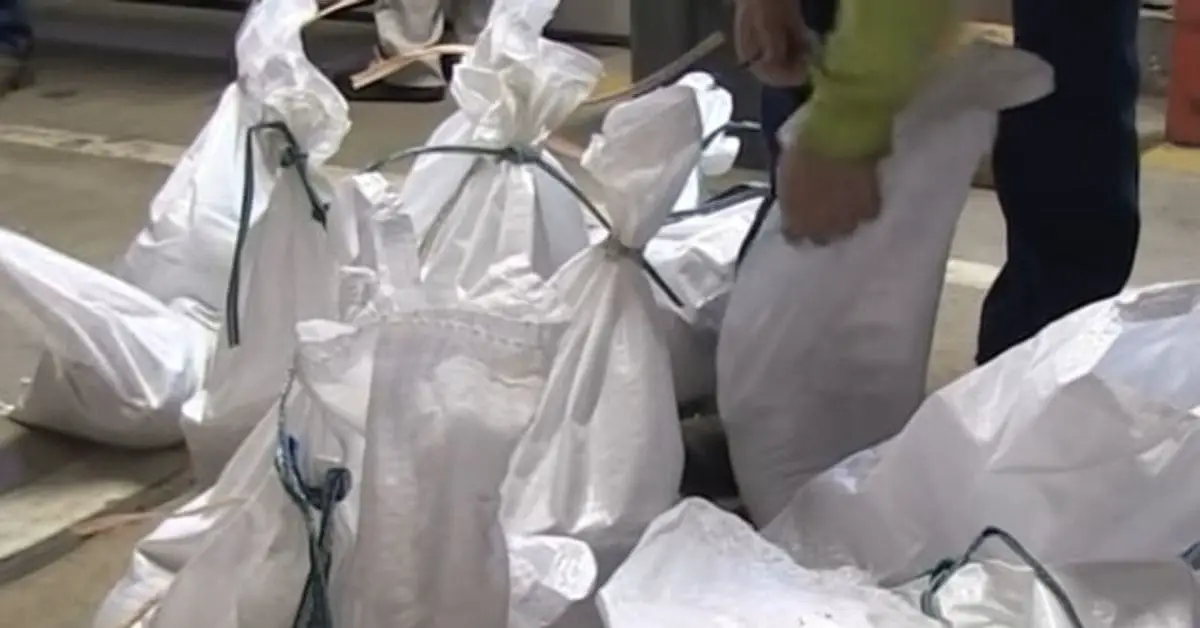
To enhance the stability of your trampoline during high winds, it is recommended to use additional sandbags. If spare bags are available, you can easily create sandbags by filling them with sand. These sandbags serve as extra weight to anchor the trampoline firmly to the ground.
When securing the trampoline with sandbags, it is advisable to place at least one sandbag separately at each U-shaped column of the trampoline. This distribution helps evenly distribute the weight and provides adequate stability to withstand strong wind gusts.
By strategically positioning sandbags around the trampoline, you can minimize the risk of it being blown off or shifting during severe weather conditions.
This simple yet effective measure adds an extra layer of security, giving you peace of mind and ensuring a safe trampolining experience for you and your family.
Best Way to Anchor Trampoline: Step By Step Guide
Here is a step-by-step guide on the best way to anchor a trampoline securely:
Step-by-Step Guide: Installing Auger-Style Anchors for Trampolines
Here is a step-by-step guide on how to install auger-style anchors for trampolines:
Invest in a Trampoline Anchor Kit:
A typical trampoline anchor kit includes 4 steel augers and 4 adjustable nylon straps. The augers are screwed firmly into the ground on both sides of the trampoline. Then, you attach the straps and tighten them to secure the trampoline.
Auger-style anchor kits are highly effective in keeping a regular backyard trampoline stable. They are designed to withstand strong winds, rain, and the movement caused by repetitive jumping.
On average, trampoline anchor kits cost around $40-50. Investing in such a kit is a worthwhile expense to ensure the safety and stability of your trampoline during use.
Measuring Placement for Trampoline Anchors:
This is the location where you will position the augers. Ideally, use a tape measure to measure each leg individually for accuracy. To ensure consistent measurements on both sides, make sure the tape measure is centered on each leg.
The specific placement and spacing of the augers may vary depending on your trampoline anchor kit design. It’s important to carefully follow the instructions provided by the manufacturer to ensure proper installation and maximum safety.
Installing the Augers by Screwing into the Ground:
To install the augers, follow these steps:
- Position the pointed tip of the auger on the ground.
- Hold the hooked upper end firmly and begin twisting the auger clockwise.
- Continue twisting until only the circular hook is visible above the ground.
- Repeat this process for each side of the trampoline.
- After installation, gently shake or jostle the augers to ensure they are securely in place.
- If you encounter difficulty while sinking the augers into the ground, try wetting the area under the trampoline. This can help reduce resistance.
To ensure proper alignment, visually inspect each auger from ground level. They should appear as vertically as possible. Vertical alignment allows for better grip and stability.
By following these steps, you can ensure that the augers are securely installed, providing optimal stability for your trampoline.
Attaching Straps to the Trampoline Frame:
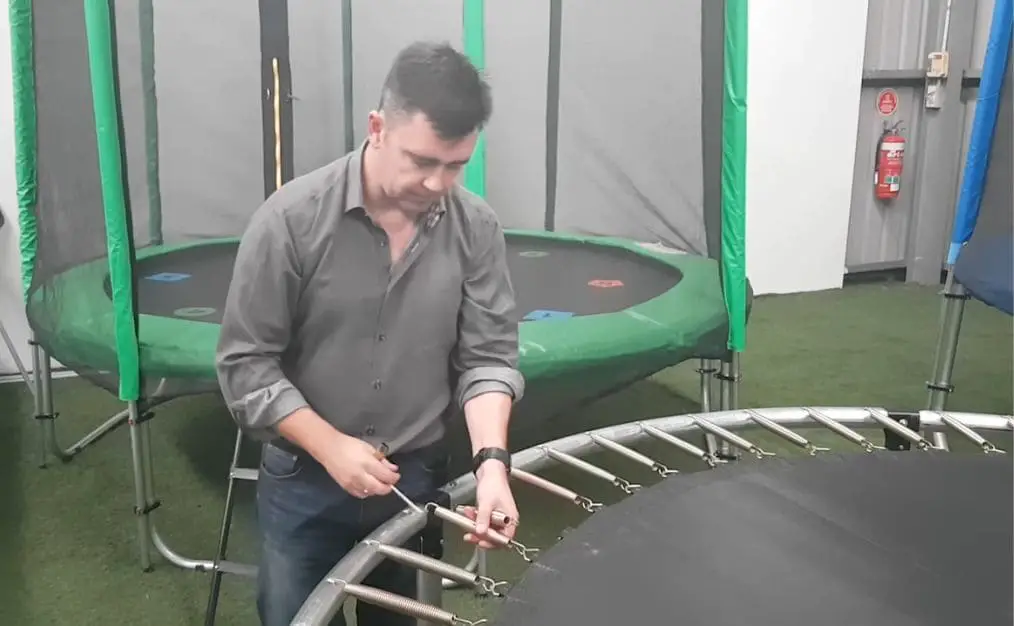
Pull the included straps up and over the circular bar directly above each auger site. Ensure that both ends of the straps hang at the same length. Your trampoline anchor kit should provide one strap for each auger.
Securing the trampoline at the top of the frame, rather than the base, provides a stronger and more secure hold.
Some anchor kits may include 2-piece straps with a separate ratchet strap. This type of system makes it easier to tighten the strap securely. In such cases, the ratchet strap is typically attached directly to the auger.
Following these steps can effectively anchor your trampoline and ensure a stable and safe jumping experience.
Guiding the Strap through the Auger:
To secure a trampoline using an auger-style anchor, insert the strap into the top hook. Once the strap is in place, align it with the buckle at the opposite end of the strap.
Make sure the strap is properly threaded through the buckle and the two ends of the strap are connected securely.
Before inserting the strap through the auger, it’s important to check that it is free from twists or tangles. This step is crucial in ensuring the strap is properly aligned and ready for use. Twisted or tangled straps can lead to a weaker hold, which may compromise the stability of the trampoline.
Once the strap is properly aligned and securely fastened, insert the auger into the ground at a 45-degree angle. Use a wrench or pliers to turn the auger clockwise until firmly anchored into the ground.
Then, use the strap to connect the auger to the trampoline, ensuring that the trampoline is stable and secure.
Regularly check the strap and the auger for any signs of wear or damage, and replace them if necessary. Following these steps will help ensure your trampoline is properly anchored and safe for use.
Feeding the Strap through the Buckle:
Thread the strap through the top opening of the buckle and pull it out from the bottom. Tighten the strap by pulling down on the free end to remove any remaining slack. Repeat this process on both sides of the trampoline.
If you use a trampoline anchor kit with 2-piece straps, insert the loose end of the frame strap through the buckle on the lower ratchet strap to create a closed loop.
It is important to make sure that you thread the strap through each buckle properly. Failing to do so increases the risk of the trampoline being overturned with enough force.
Securing and Tightening the Straps:
To ensure a secure hold, go around the trampoline and check that all the straps are tight without any give or looseness. Pulling on one strap may cause another to become loose, so it may require multiple rounds to secure everything properly.
If the free ends of the straps are long enough to reach the ground after tightening, wrap the extra length around the trampoline legs to keep them out of the way.
For trampoline, anchor kits with ratchet straps, repeatedly move the lever on each buckle up and down until there is no slack left in the straps.
Consider tying a knot to secure each strap in place to prevent the straps from coming undone.
Removing Trampoline Anchors: Reversing the Process:
To remove the trampoline anchors, follow these steps:
- Lift sharply on each buckle to loosen the straps. Then, finish undoing the straps by hand.
- Slide the frame straps away from the outer edge of the trampoline, ensuring they don’t get caught on the springs or frame.
- Twist the augers counterclockwise while gently pulling up on them until they are free from the ground.
If your current set of augers becomes damaged or loses its grip, you must purchase a new set to ensure proper anchoring of your trampoline.
Installing Wind Stakes for Trampoline Anchoring
Installing Wind Stakes for Trampoline Anchoring: Step-by-Step Guide
Using U-shaped Wind Stakes for Trampoline Anchoring:
U-shaped wind stakes are curved steel stakes designed to secure your trampoline. They are sold in sets of 4 and are easy to install. Simply place the stakes over the trampoline legs and hammer them into the ground. These stakes are affordable, typically costing around $15-20.
It’s important to note that while U-shaped wind stakes are easy to install, they may not provide as strong of a hold as auger-style anchor systems with straps.
Therefore, it’s recommended to regularly inspect the stakes for any signs of damage or instability before using the trampoline. This will help ensure a safe and secure jumping experience.
Positioning the Stakes over Trampoline Legs:
Ensure that the wind stakes are properly aligned with the trampoline legs, making sure they are evenly spaced. The prongs of U-shaped wind stakes are usually around 2-2.5 inches apart, allowing them to fit securely around the legs of most standard-sized trampolines.
This positioning ensures maximum stability and support for your trampoline. By correctly placing the stakes in this manner, you can help prevent the trampoline from being affected by strong winds or excessive movement during use, providing a safer and more enjoyable jumping experience.
Hammer in the Stakes:
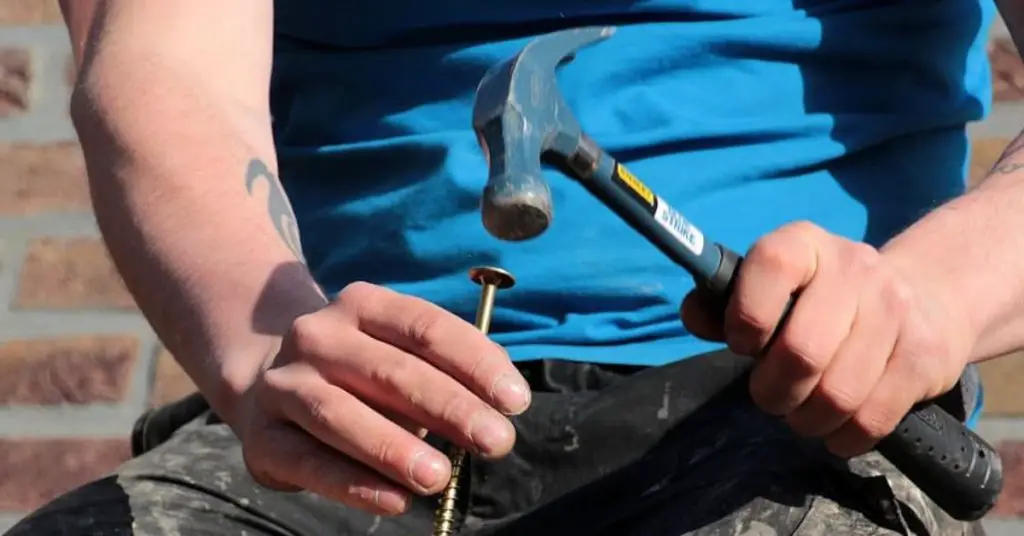
Gently tap the stakes into the ground using a hammer until they are securely seated. After placing the stakes, shake them to check if they are firmly in place.
If they feel loose, remove and reposition them, then tap them back in again.
It’s important to note that trampoline anchors, including U-shaped wind stakes, are meant for use on soft surfaces like grass or dirt. If the ground is too hard, lightly spray it with water to make it softer.
For areas prone to storms or strong winds, or if your trampoline tends to move, consider using 2 or 3 sets of stakes for added stability.
Removing U-Shaped Wind Stakes:
To remove the wind stakes, insert the blade of a screwdriver or similar tool between the stake and the trampoline leg. Lift the handle of the tool to pry up the stake. Once the stake has moved about 1-2 inches, you can easily pull it out by hand.
If the stakes are stubborn, you can use a hammer to help wedge the screwdriver. It’s important to replace any bent, broken, or rusted stakes to ensure safety and proper functionality.
Types of Anchoring Systems
Anchoring systems come in various types, each designed for a specific purpose and situation. Here are some common types of anchoring systems:
Ground Anchors:
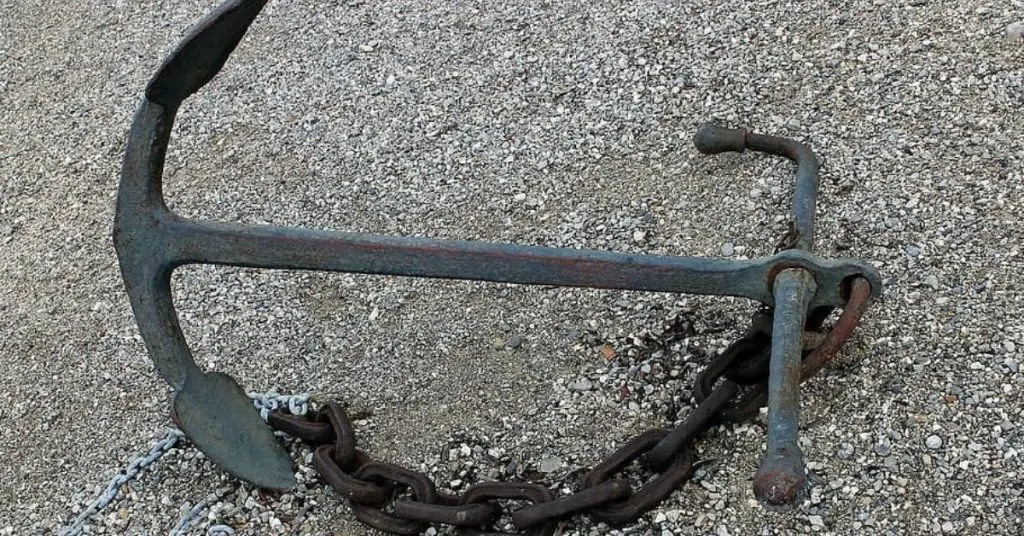
These anchors are used to secure items to the ground and prevent them from tipping over or blowing away.
Some examples of ground anchors are:
- Spiral stakes: These are long, corkscrew-shaped stakes that are twisted into the ground. They work well for securing tents, canopies, and other lightweight structures.
- Auger-style anchors: These are similar to spiral stakes, but they have a larger diameter and are used for heavier loads like swing sets, trampolines, and small buildings.
- Drive-in anchors are metal stakes with a flat head that can be driven into the ground with a hammer. They are ideal for securing outdoor furniture, portable basketball hoops, and other items.
Weighted Systems:
These types of anchors use heavy objects to keep items in place. They are particularly useful on hard surfaces where it is difficult to drive in ground anchors. Examples of weighted systems include:
- Sandbags or weighted plates: These can be placed on canopies, inflatables, and other lightweight items to keep them from flying away.
- Concrete blocks: These are heavy blocks that can secure sheds, playsets, and other outdoor structures.
Combination Systems:
These are anchors that combine elements of both ground anchors and weighted systems. They can be particularly effective in unpredictable weather or unstable soil conditions. Examples of combination systems include:
- Combination of ground anchors and weights: For instance, a shed may be anchored with auger-style anchors at the corners and weighted down with concrete blocks in the middle. Choosing the appropriate type of anchoring system can help ensure that your belongings and structures stay safe and secure, even in adverse weather conditions.
What is the process of securing a trampoline to the ground?
The method of anchoring trampolines can vary depending on the tools you choose and the type of ground you have. Here are instructions on how to anchor trampolines on grass and concrete:
Anchoring Trampolines on Concrete:
When setting up a trampoline on concrete, it is important to take precautions to ensure stability and safety. While using a trampoline on concrete is generally not recommended due to the increased risk of movement and injuries, you can still take steps to anchor it securely.
One effective method is to use sandbags to provide additional weight and stability. Start by placing sandbags on the bottom parts of the U-shaped frame, distributing them evenly around the trampoline.
The weight of the sandbags will help anchor the trampoline and reduce the risk of it shifting or moving during use.
Make sure to choose sturdy and durable sandbags capable of withstanding the weight and forces exerted on the trampoline. Position the sandbags in a way that they are securely attached to the frame, preventing them from sliding or falling off.
Additionally, it is important to regularly inspect the sandbags for any signs of wear, damage, or shifting. Replace any damaged sandbags promptly to maintain the trampoline’s stability.
Remember that while using sandbags can improve stability, it is still important to exercise caution and consider the potential risks associated with using a trampoline on concrete.
Placing trampolines on softer surfaces such as grass or a safety mat is generally recommended to minimize the risk of injuries.
How can trampolines be anchored on Grass?
If you have a grassy backyard, you have more options for anchoring your trampoline than concrete or stone surfaces. Even artificial grass can work if there is solid ground underneath.
One popular option is using trampoline anchors. These are U-shaped stakes that can be inserted directly into the ground. If the ground is hard, you may need a hammer or a stone to help with the insertion.
You will need a long screwdriver or a rod-shaped tool for auger-style anchors. Insert the tool into the ground at the desired anchor location, about 10 inches (25 cm) deep.
Then remove the tool and align the anchor’s hole with the original hole created by the tool. Replace the tool with the anchor. If you encounter a stone while inserting, try a different spot.
Another type of anchor has a round hole on top. You can use a strap to cross through the hole and then tie the strap to the trampoline frame.
Regardless of the anchor type, it is recommended to evenly spread the anchors around the trampoline frame to ensure stability.
How can trampolines be anchored to withstand high winds?
After properly anchoring your trampoline using the methods mentioned earlier, it should be able to withstand normal high winds without being lifted. However, in the case of severe weather conditions like tornadoes or hurricanes, moving your trampoline to a safe location, such as your garage, is highly recommended.
Even if the trampoline doesn’t fly off, the intense shaking caused by the strong winds can potentially damage the frame and poles, reducing its lifespan. It’s best to prioritize safety and protect your trampoline during extreme weather events.
How to Secure a Trampoline During a Hurricane?
Securing a Trampoline During a Hurricane:
- Remove the safety net and store it indoors until the storm passes: Take down the safety net surrounding the trampoline and store it inside your home or garage. This will prevent it from being damaged or blown away during the hurricane.
- Secure the trampoline frame firmly to the ground: Use strong and sturdy anchor systems specifically designed for trampolines to secure the frame to the ground. Follow the manufacturer’s instructions to ensure proper installation. This will help prevent the trampoline from being lifted or overturned by strong winds.
- Double the number of sandbags if your trampoline is on concrete: If your trampoline is placed on a concrete surface, place sandbags around the base. Consider using double the number of sandbags to provide extra weight and stability, helping to keep the trampoline grounded.
- Disassemble the entire trampoline and store it indoors if possible: If you have enough time and space, disassemble the entire trampoline and store the parts indoors. This will ensure maximum protection for your trampoline during the hurricane.
- Remove the jumping surface if bringing the trampoline indoors is not possible: If disassembling the trampoline completely is not feasible, remove the jumping surface from the frame and take it indoors. This will prevent it from being damaged or blown away by strong winds.
- Use sandbags for added weight and stability, even if the trampoline is not on concrete: Even if your trampoline is not placed on a concrete surface, having a few sandbags is still a good idea. Place them strategically around the base of the trampoline to provide additional weight and stability, reducing the risk of it being affected by high winds.
By following these precautions, you can take proactive steps to secure your trampoline during a hurricane and minimize the potential for damage or accidents.
Creative Trampoline Anchor Ideas for DIY Projects
- Fill bags with sand and place them over the trampoline feet to add weight and keep the trampoline grounded.
- Use tent pegs to secure the trampoline by attaching them to the trampoline feet.
- Drive Waratah Standards or trampoline stakes into the ground and connect them to the trampoline for extra stability and anchoring.
- If your trampoline has been damaged by severe weather, contact us for replacement parts.
Preparing Your Trampoline for Winter
Winter weather can bring stronger winds, heavy rain, and snow, so protecting your Jumpflex trampoline is important during this time. Here’s how to take care of your trampoline during the winter season:
- Remove any accessories, such as the safety net or ladder, and store them indoors.
- Clean the trampoline surface and frame to remove any dirt, debris, or moisture.
- If possible, disassemble the trampoline and store it indoors.
- If disassembling is impossible, cover the trampoline with a weatherproof cover to protect it from snow, rain, and debris.
- Regularly check the trampoline during winter for any signs of damage or wear.
- When winter is over, inspect the trampoline thoroughly before using it again to ensure it is safe and in good condition.
What is the process for securing a trampoline net?
When you have a trampoline, it’s important to know the risks associated with strong winds. The trampoline’s safety net can act like a sail and catch the wind, causing it to lift and become a potential hazard.
To keep yourself and your trampoline safe, it’s recommended that you remove the safety net when there’s a chance of high winds. This can be done by disassembling the net and letting it fall onto the trampoline mat.
It’s important to make sure that the net is completely removed from the frame, as any leftover attachment points can still catch the wind and cause damage.
Once the net is off, it’s a good idea to cover it with a tarpaulin or other protective material to prevent it from getting damaged during bad weather. When the winds have died down and using your trampoline again is safe, you can reattach the safety net by following the manufacturer’s instructions.
Taking these precautions can help ensure that your trampoline stays in good condition and that you and your family stay safe during inclement weather.
Safety Considerations
When it comes to using a trampoline, there are several important safety considerations to keep in mind:
Proper assembly and installation of the trampoline:
Follow the manufacturer’s instructions carefully when assembling and installing your trampoline. Improper assembly can lead to structural failure and potential injury.
Ensuring the trampoline is placed on a stable and level surface:
The trampoline should be placed on a flat and level surface to prevent tipping or uneven bouncing.
Regularly checking the trampoline for any signs of wear or damage:
Inspect your trampoline regularly for any wear, damage, or degradation. Replace any damaged or worn components immediately.
Supervising trampoline use and establishing safety rules:
Always supervise trampoline use and establish safety rules for users. Children should always be supervised by an adult when using the trampoline.
Using additional safety measures like safety nets and padding:
Consider using additional safety measures like safety nets and padding to minimize the risk of injury. Safety nets can help prevent falls from the trampoline, while padding can reduce the risk of injury from contact with the frame or springs.
By following these safety considerations, you can help ensure that your trampoline is used safely and minimize the risk of user injury.
FAQs:
Q:1 What is the best way to anchor a trampoline?
Combining ground anchors and weighted systems is the best way to anchor a trampoline. Ground anchors such as auger-style anchors can be used to secure the legs of the trampoline to the ground, while weighted systems such as sandbags or concrete blocks can be placed on the legs to provide additional stability.
Q:2 How many anchors do I need to secure my trampoline?
The number of anchors needed to secure a trampoline depends on the size of the trampoline and the environmental conditions in which it will be used. As a general rule, using at least 4 ground anchors for a standard-sized trampoline is recommended.
Q:3 Can I use sandbags to anchor my trampoline?
Yes, sandbags can anchor a trampoline as a weighted system. They should be placed on the legs of the trampoline to provide additional stability.
Q:4 How deep should I install ground anchors for my trampoline?
The depth at which ground anchors should be installed depends on the type of ground in which they will be placed. In general, it is recommended to install ground anchors at a depth of at least 12 inches in soil or 6 inches in concrete.
Q:5 Can I use concrete blocks to anchor my trampoline?
Yes, concrete blocks can anchor a trampoline as a weighted system. They should be placed on the legs of the trampoline to provide additional stability.
Q:6 How often should I check the anchors on my trampoline?
It is recommended to check the anchors on your trampoline regularly, at least once monthly, to ensure they are still secure and in good condition.
Q:7 Can I move my trampoline after I have anchored it?
It is not recommended to move your trampoline after it has been anchored, as this can compromise the stability of the anchors and increase the risk of injury. If you need to move your trampoline, it is best to disassemble it and then re-anchor it in its new location.
Conclusion:
When it comes to using a trampoline, safety should always be a top priority. Proper anchoring is essential to trampoline safety, as it helps ensure that the trampoline remains stable and secure during use. Combining ground anchors and weighted systems is the best way to anchor a trampoline.
Ground anchors such as spiral stakes, auger-style anchors, and drive-in anchors can be used to secure the legs of the trampoline to the ground. In contrast, weighted systems such as sandbags or concrete blocks can be placed on the legs to provide additional stability.
By using a combination of these anchoring methods, you can help ensure that your trampoline is stable and secure during use, minimizing the risk of injury to users.
It is also important to regularly check the anchors on your trampoline and follow manufacturer instructions for installation to ensure that it remains safe and secure for years.
We hope you will be well aware of the best way to anchor trampoline after reading this comprehensive article. If you have any questions, feel free to comment below!

